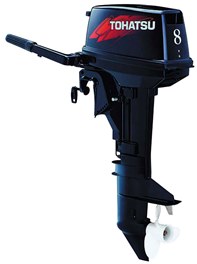“Engine Man” discovers that Nulon Marine 2 Stroke Outboard Oil outperforms Valvoline 2-Stroke Outboard Oil.
Back in 2005, when I borrowed a Tohatsu M8B outboard motor, Lakeside Marine, the national Tohatsu distributor (in Australia), suggested I use synthetic fortified Valvoline 2-Stroke Outboard Oil, which has cleaner-burning characteristics than mineral-based oils. This oil was also used in my fishing partner Di’s 1996 Tohatsu M5B outboard from 2007 onwards and in both 50:1 premix engines, has reduced spark plug fouling during extended trolling intervals.
Synthetic fortified oils also have the ability to stay in suspension with premium (95 RON) unleaded petrol, whereas mineral-based oils won’t. In 2011 when I switched from standard (91 RON) unleaded to premium in both engines, I found that the Valvoline/premium combination actually cleaned spark plugs and halved oil smoke emissions compared to using standard.
But research by Lakeside Marine has found that synthetic fortified Nulon Marine 2 Stroke Outboard Oil is even better and recommends using it in all Tohatsu carbie two-stroke outboard motors and OEDA 2-Star TLDI DFI engines.
NULON OIL VS VALVOLINE
The main problem with Valvoline 2-Stroke Outboard Oil is that it’s rated to only 50:1, preventing it from being used in 100:1 Suzuki and Yamaha outboards. Call me anal but if an oil manufacturer states 50:1 as the leanest fuel/oil ratio that can be mixed, then it’s not suitable for 100:1 engines.
However Nulon can be used at ratios from 20:1 to 100:1. And it’s also good for carbie two-stroke outboards that troll extensively because it won’t glaze the cylinder bores as can full synthetic oils.
Bombardier Recreational Products (BRP), the manufacturer of Evinrude E-TEC outboards, states that its synthetic XD100 oil is only suitable for DFI engines and if used in carbie two-stroke engines can glaze the bores during extended trolling periods, whereas the semi-synthetic XD50 won’t.
For this reason I use only XD50 in my two carbie premix two-stroke Johnson outboards because this oil is completely compatible with the Johnos which have weaker ignition systems than Tohatsus, whereas Valvoline isn’t.
Synthetic oils are brilliant at lubricating engines when used at the lean fuel/oil ratios found in DFI two-strokes, some of which troll down to 400:1. In all two-stroke outboards the oil acts as a coolant as well as lubricant, working with the watercooling to dissipate heat, so at the overall lean fuel/oil ratios of E-TECs and other DFI engines, XD100 is a more effective lubricant than XD50. Synthetic oils absorb engine heat better than mineral-based oils and were originally designed for use in gas turbine engines where the combustion chamber temperatures can be twice that of piston engines.
PERFORMANCE ON THE WATER
When switching oils the entire fuel system must be drained or “gelling” from mixing different type of oil can result, clogging the fuel filter (and oil filter in oil injected engines). In both Tohatsus I also fitted new spark plugs so the Nulon could be compared directly to Valvoline. Premium unleaded was used in both engines, as with all two-stroke loan outboards I test.
When adding oil to the petrol it mixed instantly, whereas with Valvoline the fuel tank needed a thorough shaking to mix the fuel and oil. Good start!
Both engines were subjected to controlled testing with a total of ten per cent Wide Open Throttle and 20 per cent trolling operation and midrange rpm cruising in between.
With its effective thermostat I expected the M8B to run cleanly. On cold starting there was only a puff of oil smoke and never any when trolling or at any other time during testing. After the trials the spark plugs were as-new with no combustion chamber deposits on the outer or centre electrodes and the porcelain insulators pure white as though the plugs had never been used. Even when freshwater flushing the engine, where I use a mix of 25:1 and Evinrude 2 + 4 Fuel Conditioner to keep the fuel “fresh” for up to one year, again there was only a puff of smoke on starting and none during the flushing.
More surprising was how well Nulon performed in the M5B which doesn’t have a thermostat and runs very cold when trolling. A small puff on cold starting, then only a whiff of smoke after 15 minutes or more of trolling but amazingly, no oil smell in following winds. When checked after the on-water run the spark plug had only slight deposits on the outer electrode but the porcelain insulator was pure white. On flushing the engine using the 25:1/Fuel Conditioner mix there was a puff of smoke on starting and the occasional puff during flushing but again no smell.
So no more clouds of oil smoke on cold starting or during trolling. Two-strokes are even more appealing now!
THE VERDICT
Although more expensive by around $5 per litre than the Valvoline product, the Nulon outboard oil is clearly a better product and so get my recommendation. For more info on Nulon Marine 2 Stroke Outboard Oil visit nulon.com.au.
NULON OIL GUIDE FOR OUTBOARDS
Nulon engine oil can be used in these outboards
• All Evinrude and Johnson carbie premix and oil-injected two-strokes where XD50 is not available.
• All Mariner and Mercury carbie premix and oil-injected two-strokes where Quicksilver Premium Plus oil is not available.
• All Suzuki carbie premix and oil-injected two-stroke outboards.
• All Tohatsu carbie premix and oil-injected and OEDA 2-Star TLDI DFI two-stroke outboard motors.
• All Yamaha carbie premix and oil-injected and HPDI DFI two-stroke outboards.
I recommend using premium unleaded (95 RON, never 98) in all of these outboard engines, regardless of age, providing it’s mixed with semisynthetic or synthetic fortified oils.
See the full version of this review in Trade-A-Boat #247, November / December 2014. Why not subscribe today?


